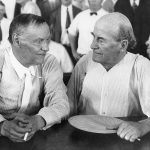
When twenty-year-old ranch hand Antonio Rodriguez was lynched by a mob in Rocksprings Texas on November 3, 1910, no one that day knew how that act of brutality and murder would play a major role in changing the course of history of the two nations separated by the Rio Grande River.
The story is still little known in both countries. I first heard the story by reading the book, Bad Mexicans: Race, Empire & Revolution in the Borderlands by Kelly Lytle Hernández.
Rodriguez had been accused of murdering a White woman in Rocksprings. A Lynch mob of 400 quickly formed and hunted him down. He was captured and denied an opportunity to have his day in court. He was set ablaze at the base of a mesquite tree and burned to death.
According to a local paper in San Antonio, the residents of Rockspings “returned quietly to town and business was resumed.” This was often the case when lynchings occurred in the United States. As was also pretty normal, no one was arrested or held accountable for the lynching of Rodriguez.
The response to the lynching was completely different in Mexico and among the Mexican community in the United States. Mexican American journalists in the U.S. and newspapers in Mexico referred to Americans as barbarians.
In less than a week, riots spread across Mexico, with residents taking their anger out on U.S.-owned businesses. As property was destroyed, Henry Lane Wilson, U.S. ambassador to Mexico, called on Mexico’s leader, General Porfirio Diaz to put an end to the “anti-American disturbances.”
Diaz had gained leadership during a coup in 1876 and opened the doors of Mexico to foreign investors, many of them from the United States. By 1900, one-fourth of Mexico’s arable land, over 130 million acres, was owned by U.S. citizens. They expected Diaz to protect their property.
Land that had been claimed by the rural and Indigenous communities was taken over by Diaz. He sent in the military to evict protestors and those who refused to leave the land. Many of them would be deported to the jungles of southern Mexico. Diaz supported the investors, making him very unpopular to many Mexican citizens.
The protests continued despite the arrests that Diaz ordered. Diaz threatened to end the protest and silence the press who had written about the lynching and protests. At the time of the lynching, Mexican exiles in the U.S. were planning a revolt against Diaz.
Ricardo Flores Magón and his followers known as the magonistas, poor Mexicans who had been displaced as land was given to U.S. companies, wanted Diaz gone. In 1910, they began to launch attacks on the Diaz regime.
Revolution was brewing in Mexico as dissatisfaction with President Diaz grew across the country. Francisco Madero was one of Mexico’s wealthiest men, and while living in the United States, he called for an armed uprising against President Diaz. The President had maintained a brutal strike force, the rurales, to maintain control over the country. The rurales had killed over 10,000 people under Diaz’s rule.
Magón’s followers, the magonistas, were mostly poor men and women who had been displaced from their homes when the land was given to foreign investors by President Diaz. By 1910, over $500 million had been invested in Mexico by American companies. These American landowners were alarmed at the state of affairs south of the border and called on President William Howard Taft to send a clear message to President Diaz about protecting American “interests” in Mexico.
President Taft responded by sending Ambassador Henry Lane Wilson to deliver a message to President Diaz. Diaz informed Wilson that he had “given orders to the authorities of the whole Republic to act with the necessary energy to suppress any further agitation because of the Texas matter, and that if anything of the kind should happen again, those who participated in any demonstrations would be dealt with all the severity of the law.”
President Diaz blamed the unrest on Magón and Madero, ignoring the sentiment of many people in Mexico who were in favor of the protests and displeased with the president. By November 6, 1910, with armed men approaching the Rio Grande under the leadership of Magón, Diaz informed Ambassador Wilson that revolution was brewing and that the U.S. could end it.
He told Wilson “Unless the American Government prevents these men from making an open revolutionary propaganda against the Mexican Government … a more serious disturbance might be expected.” American authorities in Texas refused to arrest Madero and his followers even though they were well aware that they had been stockpiling an arsenal of weapons and smuggling them across the border.
Under Magón, the rallying cry for the revolution became Tierra y Libertad!” (Land and Liberty!), because they demanded the return of the land that had been given to foreign investors. Magón insisted that Díaz’s economic policies had made Mexicans the “servants of foreigners.”
The U.S. government, as well as Diaz’s paid informants in the U.S., tried to undermine the revolutionaries in the United States. The magonistas had previously recruited White supporters in the U.S., including labor organizers Mother Jones and Eugene V. Debs, who instigated a series of political assaults that deeply wounded Díaz’s political standing on the world stage, according to Hernandez.
Hernandez stated that, “Francisco Madero, Francisco “Pancho” Villa, Emiliano Zapata, and others took the Mexican Revolution through its fighting phase.” The fighting ended after seven years and a new Constitution was drawn up which asserted public ownership of the land. It also restored many of the things the magonistas had called for, including protections for Mexico’s poorest workers.
During the revolution, more than a million Mexicans fled to the United States, giving rise to the first generation of Mexican Americans. Despite a mass deportation campaign during the Great Depression, the growth of Mexican Americans continued. By 1980, Mexicans were the largest immigrant group in the United States.
Just 30 years later, the Pew Research Center said that more immigrants from Mexico had arrived than from any other country in U.S. history. They now represent the largest non-Caucasian group in the United States. The Mexican Revolution changed the course of U.S. history and immigration law.
Hernandez wrote that “Foreign investment in Mexico triggered the rise of Mexican labor migration to the United States. Dispossessed in Mexico, millions of Mexicans first migrated within Mexico, to towns and cities, factories, haciendas, and mines in search of work. Then they began crossing the border, following the railway lines funded by investors to extract and export Mexico’s natural resources. By 1920, Mexican labor migrants comprised the American West’s single largest low-wage labor force, driving the region’s emergence as a global economic powerhouse.”
Despite the fact that Arizona has outlawed the teaching of Mexican-American history and the Texas State Board of Education rejected the adoption of a Mexican-American studies textbook, that history is a fundamental part of any real understanding of American history in the twentieth century.
Over five hundred Mexicans were lynched in the United States between 1848 and 1928. None of those lynchings would have the same impact on history as Antonio Rodriguez.
© Photo
Library of Congress and Russell Lee / Dolph Briscoe Center @ University of Texas-Austin















